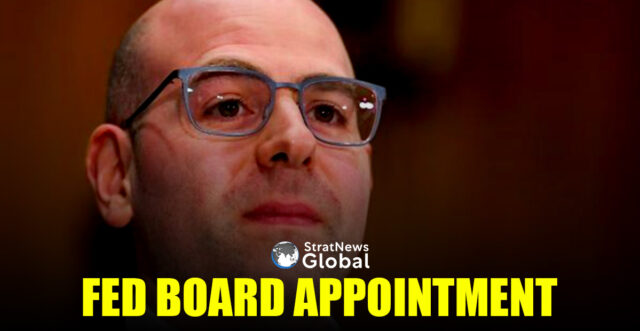U.S. President Donald Trump on Thursday announced his plan to nominate Council of Economic Advisers Chairman Stephen Miran to fill the remaining months of a newly vacant position on the Federal Reserve. The White House is also continuing its search for a permanent board member and a new Fed chair.
Miran, who has called for a complete overhaul of the Fed’s governance, will take over from Fed Governor Adriana Kugler following her surprise resignation last week, as she returns to her tenured professorship at Georgetown University.
The term expires January 31, 2026 and is subject to approval by the Senate.
Trump said the White House continues to search for someone to serve in the 14-year Fed Board seat that opens February 1. Trump is also weighing options for a successor to Fed Chair Jerome Powell, whose term ends May 15, 2026.
Trump’s Clash With Fed Policymakers
Trump has unsuccessfully pressured Fed policymakers — who include Powell, his six fellow Board members and the 12 Fed bank presidents – to lower interest rates.
Appointing Miran to the central bank, even in a placeholder role, gives the president a potentially more direct route to pursue his desire for easier monetary policy and sway over the world’s most influential central bank.
“Near term, an interim Fed governor Miran gives Trump the best of both worlds: immediate policy influence without surrendering Fed Chair optionality and leverage,” LHMeyer analyst Derek Tang wrote. “Disruption from within is a bonus.”
Miran, in a paper he co-authored last year for the Manhattan Institute, laid out a case for increasing presidential control of the Fed Board, including by shortening their terms. He also wants to end the “revolving door” between the executive branch and the Fed, and nationalize the Fed’s 12 regional banks.
It is unclear how much time he would have at the Fed to try to deploy such far-reaching reforms, most of which would require Congressional action, or even to vote on interest rates.
Tough Questions
All Fed nominees require Senate confirmation, a process that includes a hearing before the Senate Banking Committee, a vote from that panel advancing the nomination and a series of floor votes before the full Senate, where Democrats have been slowing the pace of approval for Trump appointments.
“I look forward to quickly considering his nomination in the Senate Banking Committee and hearing more about his plans to increase transparency and accountability at the Federal Reserve to ensure the agency prioritizes its mandate and avoids politics,” Senate Banking Committee Chairman Tim Scott said.
The panel’s top-ranking Democrat Elizabeth Warren said she would have “tough questions for him during his confirmation hearing about whether he’d serve the American people as an independent voice at the Fed or merely serve Donald Trump.”
The Senate is not due to reconvene until September 2, at which point Congress will also be turning to the pressing challenge of funding the government past the end of the month or triggering a partial federal agency shutdown.
There are just four policy-setting meetings, including one on September 16-17, before the end of what would be Miran’s term.
Fed policymakers kept the policy rate in its current 4.25%-4.50% range at their July meeting, with Powell citing somewhat elevated inflation and the concern that Trump’s tariffs could keep it that way as reasons to keep policy restrictive.
After a government jobs report released Friday showed far fewer job gains in recent months than earlier estimated, sentiment within the central bank may already be moving toward a rate cut as early as the Fed’s next meeting.
Several central bankers this month have raised concerns about labor market weakness, and at least a couple have expressed renewed confidence that tariffs may not push up on inflation as much as earlier thought. Those views echo the arguments made by two Fed governors — both Trump appointees — who last month dissented on the decision to leave policy on hold.
Miran earlier on Thursday praised one of those dissenters, Fed Governor Christopher Waller, for avoiding “tariff derangement syndrome,” a phrase meant to denigrate concerns about the economic effects of the Trump administration’s sharply higher import levies.
Waller is said to be the preferred candidate among Trump’s team to succeed Powell as Fed chair.
(With inputs from Reuters)





